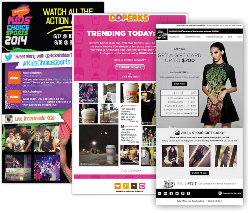
jmexclusives / Pixabay
Social media is a new way to reach customers, and every business that has found success with its audience has a solid digital marketing strategy. It also comes with other benefits, including increased visibility, customer and audience engagement, and increased website traffic and ranking.
Billions of people around the world enjoy going to different social platforms for information, entertainment, virtual interaction, and making transactions. As such, businesses have turned to social media community managers to represent their brand across social channels by posting content online.
What is Social Media Automation?
Automation in social media can best be described as using software tools to maintain a brand’s online presence. This often includes social media tasks such as creating scheduled posts, speeding up response time for inquiries using bots, curating content to share, and producing analytics reports.
How Do You Automate on Social Media?
There are free and paid social media automation tools to cater to most networks. The most appealing aspect of these tools is their ability to trim down the time needed for social media management. This is especially useful for large companies with hundreds of business profiles and pages, agencies that handle several clients, and for businesses with a small marketing team.
Some social media automation tools have better features than others. Apart from advanced scheduling, some tools allow you to monitor, react, and add comments natively for engagement. Others provide insight for all used platforms and provide content curation ideas.
Is There Really a Best Time to Post?
With how prevalent social media automation is, several articles on when best to post on different platforms have been published. Most of them have a differing opinion on posting times, with so many factors to consider such as niche, audience type, and location.
This only means that there is no cut-and-dried publishing schedule for social media automation. The best way to figure out what works best is through old-fashioned trial and error.
Pitfalls of Social Media Automation
In this fast-paced digital era, markets are fiercely competitive. And while online brand presence is important, it should also have a human touch. Brand strategies are ever-evolving and while it is mainly to help grow an online presence, most companies are recognizing that a great customer experience with meaningful personal interactions is an important aspect of brand longevity.
With that said, overreliance on bulk scheduling seems contradictory for brands aiming for a more authentic customer approach. Here are more pitfalls of social media automation:
Sharing and forgetting – Coming up with something to post is by no means an easy feat. In the desire to create something unique, marketers often tunnel-vision on the task. This means putting it on a scheduler to be posted later and then forgetting live engagement. A good post could have the biggest organic reach, but forgetting to respond to inquiries and comments could render it pointless. Once an audience sees an unresponsive brand, they will move on to competitors instead.
Not utilizing a platform’s unique feature – Some socials are media-based while others are better with text, and others create more impact with both. It is not a good idea to post the same content to all channels as this will seem spammy. Customize posts for each platform so that people will not lose interest due to an unnecessary wall of text, a misplaced hashtag, or an unclickable link.
Not joining in on trending topics – An influx of content ideas and promotions can easily fill up a weekly or monthly social media calendar. Adding too many scheduled posts will not leave room for opportunities to jump in on industry-specific trending topics and breaking news. When that happens, there’s a chance that all the lined-up posts for the day could be pushed back or be out of sync with ongoing campaigns.
Brands and businesses often use a strategy named trendjacking to get their share in the spotlight. Opening a conversation or engaging in a thread on a current hot topic will help you connect with audiences. But it can be a tricky tightrope walk, especially if the interaction is not on brand.
Sounding too robotic – The “set it and forget it” mindset may have brands sounding robotic and impersonal. It does not help that some tools make it obvious that content is posted by a scheduler. The best way for brands to not sound mindless is to post in real-time, especially for brand-related activities like promotions and news.
Another way to keep up-to-date with audiences is to turn on notifications for direct messages, mentions, and other notifications. Responding in a timely manner will let consumers and potential clients know that there is an actual human behind the accounts.
Overdoing it – Uploading posts in bulk across socials at the same time can feel spammy to followers. Interest can be fleeting online, and instead of getting attention for expertly crafted content, the audience may skip them because they have seen it too much.
Additionally, canned autoresponses may be helpful for answering common inquiries, but there should be personalized messages in between. Some questions may be too complex and computer-generated messages will miss the mark and potentially lose customers when they feel unheard or not listened to.
Key Takeaways
While social media automation can help save time and streamline bulk processes, never lose sight of what is most important: engagement. Although convenient, it is neither a reliable nor effective way of increasing brand awareness. This is not to say that you should stop using automation tools altogether. Rather, there should be a healthy balance of post automation and organic post creation. Here are other things to consider:
Intelligent automation – Keep social marketing from getting impersonal by adding a personal touch. It takes time and dedication to create quality content ahead of schedule and to keep those efforts from being wasted. Strategize regular posts to be shared consistently later. This is where automation tools come in.
At the same time, look out for related viral posts and chime in on conversations to engage and capture the attention of the audience. Remember that automation is meant to supplement brand interaction and presence by letting it do the grunt work, but it is never an acceptable replacement for meaningful interactions.
Tailor-fit posts for each network – Socials have unique features, and that is why it is important to tailor content to fit them. Posts in some networks may do better with video content while some are only great with a short caption and a link. Most channels have best practices and guidelines for making content. They change from time to time, so always be on the lookout for those.
Additionally, each platform has its own set of algorithms, so try out different forms of content. Adding interactive content on top of text posts, infographics, videos, and gifs is important for variety, and the metrics will show which of these perform best. Keep the intended audience in mind when creating posts and consider adding ways to get audience feedback while keeping it fun if it fits the brand.
Always bring value – Conversion and making sales are just part of social media, and while it is tempting to feature products and services in every post, it can get boring fast. No one wants to follow a profile when it is constantly pitching stuff. It is almost the equivalent of getting annoying cold calls or getting email spam.
Post content that the audience wants to read or to be updated on. Improve how your business is seen on social media by providing value in your posts. You can do this through storytelling, discussing hot topics, holding contests and giveaways, and asking questions to encourage audience participation.
Check, improve, and stay updated – The most crucial aspect of marketing is keeping an eye on social profiles to ensure that everything is working well. Monitor progress by checking metrics and KPIs to see if there are processes that need to be improved or engagement tactics that need changing.
On top of tracking campaigns, it is important to stay updated with what is new on the internet. New platforms crop up on the daily and existing ones roll out new features and changes constantly. Additionally, it helps to identify loyal followers who consistently engage, as they can help build the brand’s social community.
Build a reputation – Having brand equity means being a household name. This is one of the loftiest goals a business can achieve. It can be difficult to become a thought leader in competitive niches with established brands, but it is possible in others. Becoming a leader in the industry means having proven expertise and a robust online presence that is developed through a sound marketing strategy.
Thought leadership is not being overly promotional. Instead, it focuses on providing high-value content, whether in writing, video, or speech. Showcasing the faces behind the brand humanizes it and attracts people looking for a product or service relevant to their interests.
Digital & Social Articles on Business 2 Community
(23)








